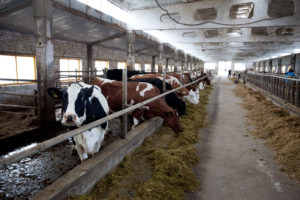- Antibiotics Tests in Milk
- Inhibitory detection test
- Laboratory equipment
- Centrifuges
- Indicator strips
- Autoclaves
- Scales
- Thermometers
- Packing
- PureTrust ATP monitoring
- ATP monitoring PIONEERPRODUKT CleanTrust
- MICROFAST® substrates
- Nutrient media
- Ice cream sticks
- Consumables
- Detergents and disinfectants
- Treatment agent
- Milk filters
- Wipes
- Gloves
- Sampling
Azerbaijan increases meat imports: causes and consequences
In January-February 2024 , Azerbaijan continued to increase its spending on MEAT imports , which indicates growing demand for this product in the country. According to the State Customs Committee, during the specified period, 8,180 tons of meat were imported, with a total value of 17 million 442 thousand US dollars . These figures exceed last year's figures by 858 tons (11.7%) in quantitative terms and by 5 million 450 thousand US dollars (45.4%) in value terms.
Why does Azerbaijan decide to increase meat imports? There are several possible reasons. First, the country's growing population demands more food products, including meat . An increase in population brings with it an increased demand for nutritious and protein-rich foods, and meat is one of the main sources of protein.
Second, Azerbaijan's agriculture industry may have difficulty producing enough meat to meet growing domestic demand. Despite the development of domestic agriculture, sometimes economic and climatic factors can make it difficult to sustainably produce meat in sufficient quantities. In such cases, imports become an important source to compensate for the lack of domestic production.
A third reason for the increase in meat imports may be due to the diversity of consumer preferences. Azerbaijani consumers may prefer certain types of meat that are not produced in sufficient quantities in the country. In such cases, imports make it possible to satisfy the taste preferences of the population and offer a larger range of products on the market.
The increase in meat imports has its consequences, both positive and negative. On the one hand, this makes it possible to satisfy the growing demand for meat and provide the population with nutritious foods. On the other hand, this may have a negative impact on domestic meat producers who face competition from imported goods. To support domestic producers, it is necessary to develop and implement appropriate measures, such as subsidies or tax preferences.
Overall, the increase in meat imports in Azerbaijan is a reflection of the changing needs and preferences of the population. This provides new opportunities for market development and meeting demand for food products, but also requires active measures to support domestic producers and ensure sustainable agricultural development.
 Express-tests PIONER 5 in1 for the determination of thiamphenicol, meloxicam, colistine, trimethoprim, sulfonamides
Express-tests PIONER 5 in1 for the determination of thiamphenicol, meloxicam, colistine, trimethoprim, sulfonamides Rapid 4 in 1 tests for determining the residual amount of neomycin, kanamycin, gentamicin, spectinomycin in milk, whey
Rapid 4 in 1 tests for determining the residual amount of neomycin, kanamycin, gentamicin, spectinomycin in milk, whey PIONEER MEIZHENG BIO-TECH (5 in1) JC0871/ Rapid tests for the determination of the residual amount of β-lactams, tetracyclines, chloramphenicol, streptomycins, ceftiofur in milk, whey.
PIONEER MEIZHENG BIO-TECH (5 in1) JC0871/ Rapid tests for the determination of the residual amount of β-lactams, tetracyclines, chloramphenicol, streptomycins, ceftiofur in milk, whey. Express tests for determining the residual amount of β-lactams and tetracyclines in milk, whey
Express tests for determining the residual amount of β-lactams and tetracyclines in milk, whey TEST KIT for determination of inhibitory agents PIONEERPRODUKT® DASH-TEST, WC0040
TEST KIT for determination of inhibitory agents PIONEERPRODUKT® DASH-TEST, WC0040 Rapid tests PIONER 5 in 1 for the determination of sulfonamides, tylosin, tilmicosin, lincomycin, erythromycin, fluoroquinolones
Rapid tests PIONER 5 in 1 for the determination of sulfonamides, tylosin, tilmicosin, lincomycin, erythromycin, fluoroquinolones- ANTIBIOTICS / ELISA TESTS
- Rapid tests for determining the residual amount of tetracyclines in meat
- Rapid tests for determining the residual amount of chloramphenicol in meat
- Rapid tests for fluoroquinolone, erythromycin, lincomycin, tillosin and tilmycosin residues in milk, whey
 Milligram weights
Milligram weights Bürkle Qualirod tapered sampler 120 and 170 mm immersion depth
Bürkle Qualirod tapered sampler 120 and 170 mm immersion depth PAL series digital pocket refractometers (Atago, Japan)
PAL series digital pocket refractometers (Atago, Japan) Infrared analyzer "SibSCAN" (dairy products)
Infrared analyzer "SibSCAN" (dairy products) Tagler TSLM 1-8 milk centrifuge (without heating) (Russia)
Tagler TSLM 1-8 milk centrifuge (without heating) (Russia) Indicator strips "CHAS-100 mg",100 pcs
Indicator strips "CHAS-100 mg",100 pcs- Memmert IPP cooling incubators (Germany)
- Residual Acidity Test Strips, 100 pcs.
- Laboratory table on supporting pedestal BA-CL-X.X SLv-t TR -a
- HI 8424 portable pH/ORP meter/thermometer (pH/ORP/T)
- Laboratory pH meter/ORP meter/thermometer HI 5221-01 (pH/ORP/T) (Hanna, Germany)
- HI 98509 Checktemp 1 Portable Electronic Thermometer with Remote Sensor
- Milk Analyzer "Expert Pro"
- Thermohygrometer Testo 608-H1
- LactoScope FT-B - Milk Analyzer with Limited Capabilities for Cream
 Plastic packaging for cakes and pastries
Plastic packaging for cakes and pastries Parchment
Parchment KH PACK® bag making paper
KH PACK® bag making paper Carton
Carton Laminating paper KH PACK®
Laminating paper KH PACK® The paper packing fastened anticorrosive UNIK 14-70 THAT 5453-003-05773103-2005
The paper packing fastened anticorrosive UNIK 14-70 THAT 5453-003-05773103-2005- GableTop aseptic packaging
- Cover
- Grease and barrier paper KH PACK®
- Korreks for desserts
- KH PACK® Straight Packing Paper
- Ice cream chopsticks
- Salad dressings
- Paper sacks
- Cartons for milk and dairy products
 Pepsin whey pork
Pepsin whey pork Ice cream sticks (round)
Ice cream sticks (round) Auxiliaries for sugar products
Auxiliaries for sugar products Wafer cup and cone
Wafer cup and cone Petri dish 90 mm
Petri dish 90 mm Ice cream sticks Standard 114
Ice cream sticks Standard 114- Ice cream sticks (with logo)
- Ice cream sticks Standard 93
- Ice cream sticks Magnum (curly)
- J-Bottom technology
- General purpose environment of SPC "Biocompass-S" (Uglich)
 Plastic syringe 150ml
Plastic syringe 150ml Mug for milking the first streams of milk.
Mug for milking the first streams of milk. Pencils for marking animals
Pencils for marking animals Self-adhesive hoof bandage
Self-adhesive hoof bandage Anti-catfish milking rings
Anti-catfish milking rings Dosing syringe, hose attachment
Dosing syringe, hose attachment- Non-returnable cup for udder treatment
- Milk filters - primary cleaning
- Foam cup for udder treatment
- Veterinary glove to the shoulder and through the neck
- Apron and armlets
- Spatula for mastitis test (Shalm's test)
- Liquid soap "Prestige" (yellow, green, red) 5 l
- Cassettes for DCC somatic cell counter
- Hoof bath
 MicroFast® Enterobacteriaceae Count Plate (cat. no. LR1011)
MicroFast® Enterobacteriaceae Count Plate (cat. no. LR1011) MicroFast® Lactic Acid Bacteria Count Plate (Part Number LR1312)
MicroFast® Lactic Acid Bacteria Count Plate (Part Number LR1312) Substrate for determining QMAFAnM (catalog number LR1001)
Substrate for determining QMAFAnM (catalog number LR1001) Substrate for determining the number of staphylococci (Catalog number LR1005) MicroFast® Staphyloccocus aureus Count Plate
Substrate for determining the number of staphylococci (Catalog number LR1005) MicroFast® Staphyloccocus aureus Count Plate MicroFast® Staphyloccocus aureus Confirmation Plate Staph.aureus Confirmation Plate (cat. no. LR1005Q)
MicroFast® Staphyloccocus aureus Confirmation Plate Staph.aureus Confirmation Plate (cat. no. LR1005Q) MicroFast® Environmental Listeria Count Plate
MicroFast® Environmental Listeria Count Plate- Coliform Count Plate (catalog number LR1002) MicroFast® Coliform Count Plate
- MicroFast® Coliform & E.coli Count Plate
- MicroFast® Bacillus cereus Count Plate (catalog number LR1010)
- MicroFast® Salmonella Count Plate (SAL), for the determination of Salmonella in food and environmental samples (Catalog #LR1006)
- Yeast & Mold Count Plate (cat. no. LR1003) MicroFast® Yeast & Mold Count Plate
- MicroFast® Microbiological Substrates
- Substrate for accelerated determination of QMAFAnM, (catalog number LR1321)
 Belstat reported how much grain, milk, meat, and vegetables are produced in Belarus per capita.14.11.2025
Belstat reported how much grain, milk, meat, and vegetables are produced in Belarus per capita.14.11.2025 "Коллективы АПК способны решать любые задачи даже в непростых условиях". Назаров о заслугах сельхозпроизводителей14.11.2025
"Коллективы АПК способны решать любые задачи даже в непростых условиях". Назаров о заслугах сельхозпроизводителей14.11.2025 "Белорусские продукты - страновой бренд". В Гродно поздравили работников сельского хозяйства области14.11.2025
"Белорусские продукты - страновой бренд". В Гродно поздравили работников сельского хозяйства области14.11.2025- He crawled to the icon with prayer. The true story of a man who overcame drug addiction.14.11.2025
- Лучшие не только по молоку. Какие рекорды поставили в экспериментальной базе имени Котовского13.11.2025
- "Душа радуется, когда видишь результат". Что для аграриев Витебской области важнее наград13.11.2025
- К концу года здесь установят новый рекорд по надоям! В чем секрет успеха ОАО "Великий Двор"13.11.2025
- Как делают колбасу из козлятины, которую оценил Лукашенко? Раскрываем секреты технологического процесса13.11.2025
- Порядок наводят, но нарушения остались. КГК проверил 46 сельхозорганизаций Витебской области 13.11.2025
- Нуга с фруктами, масло с прованскими травами: какие новинки у белорусских предприятий пищепрома 13.11.2025
- Брянская область вошла в число лидеров среди регионов России по товарообороту на БУТБ12.11.2025
- На БУТБ впервые реализовано пюре экзотических фруктов12.11.2025
- Роботизация молочных ферм и ускоренная обработка почвы: что ученые предлагают сельскому хозяйству12.11.2025
- Taking into account the latest advances in animal husbandry, the MTC was officially opened in the Ostrovets District.07.11.2025
- В Беларуси скорректированы ветеринарно-санитарные правила для производителей молочной продукции 07.11.2025
- "Вода лечит, дает силы". Этот белорус строит уникальные лодки 07.11.2025
 Фермеру на Камчатке вынесли предостережение за нарушение правил утилизации биологических отходов14.11.2025
Фермеру на Камчатке вынесли предостережение за нарушение правил утилизации биологических отходов14.11.2025 The Russian Ministry of Agriculture proposes extending veterinary regulations until 2032.14.11.2025
The Russian Ministry of Agriculture proposes extending veterinary regulations until 2032.14.11.2025 Шотландская компания запускает проект Pig Insights для улучшения здоровья свиней с помощью искусственного интеллекта14.11.2025
Шотландская компания запускает проект Pig Insights для улучшения здоровья свиней с помощью искусственного интеллекта14.11.2025- ILPRA представляет трассилер FoodPack 1485 для упаковки свежего мяса птицы в стретч-плёнку14.11.2025
- Банк России ожидает основной эффект от повышения НДС на инфляцию в январе 2026 года14.11.2025
- Новый законопроект об ответственности за утилизацию отходов принят Госдумой в первом чтении14.11.2025
- Потребительские цены: Небольшое увеличение и снижение темпов роста в ноябре14.11.2025
- Рост производства мяса птицы в Казахстане: достижения и перспективы14.11.2025
- Суд Рязани оштрафовал ООО «Жито» за нарушения в контроле качества мяса14.11.2025
- В Красноярске выявили несанкционированную торговлю мясом14.11.2025
- Татарстан планирует создать новую породу гусей14.11.2025
- A fire at the Merci Agro Sakhalin pig farm killed 1,500 pigs, but pork production will not be affected.14.11.2025
- Министр сельского хозяйства предлагает долгосрочные контракты для стабилизации цен на продукты13.11.2025
- Russian agriculture: self-sufficiency continues to grow13.11.2025
- Sustainable growth of the food and processing industries in Bashkortostan13.11.2025
- The State Duma has passed 71 laws to support agriculture starting in 2021.13.11.2025
 10 reasons to take a deposit04.05.2025
10 reasons to take a deposit04.05.2025 The IEA sees a risk of a decline in oil production in Russia due to sanctions.14.11.2025
The IEA sees a risk of a decline in oil production in Russia due to sanctions.14.11.2025 UniCredit заявил о галактических усилиях из-за санкций против России14.11.2025
UniCredit заявил о галактических усилиях из-за санкций против России14.11.2025- США объяснили снятие санкций с проекта АЭС в Венгрии с участием России13.11.2025
- Зеленский ввел санкции против своего бизнес-партнера13.11.2025
- Ukrainian companies have been hit by US sanctions due to their ties to Iran.13.11.2025
- Канада ввела санкции против Игоря Чайки и «Арктик СПГ 2»13.11.2025
- Princess Eugenie's art gallery has been accused of violating sanctions against Russia.13.11.2025
- Reuters узнал, что ЛУКОЙЛ после санкций обратился с просьбой к США13.11.2025
- Рубио завил, что США «особо не на что накладывать санкции» против России13.11.2025
- Британия запретит морские перевозки российского СПГ12.11.2025
- Tokyo called the entry ban on 30 Japanese citizens to Russia unacceptable.12.11.2025
- Kyiv imposed sanctions against Dmitriev and Russia's negotiator in Istanbul.12.11.2025
- Guardian рассказала, как Австралия продолжает получать российскую нефть12.11.2025
- США частично сняли санкции с Сирии12.11.2025
- Bloomberg рассказал о «настоящей драке» в Европе из-за активов ЛУКОЙЛа12.11.2025
 Pharmaceutical companies see a threat to EU security due to bacteria in Ukraine13.11.2025
Pharmaceutical companies see a threat to EU security due to bacteria in Ukraine13.11.2025 В Британии предупредили о риске для миллионов из-за супербактерий06.01.2025
В Британии предупредили о риске для миллионов из-за супербактерий06.01.2025 Moscow court sides with Indian company in dispute with Health Ministry26.11.2024
Moscow court sides with Indian company in dispute with Health Ministry26.11.2024- Scientists estimate increase in mortality due to drug-resistant bacteria29.10.2024
- Antibiotics for livestock and pesticides found in poisoned family's home29.10.2024
- Izvestia reported on the shortage of widely used antibiotics in Russia29.10.2024
- The Ministry of Health called data on the shortage of antibiotics unreliable29.10.2024
- Scientists warn of threat of return to pre-penicillin times29.10.2024
- The Ministry of Health explained how attitudes towards antibiotics changed during the pandemic07.05.2024
- WHO explains the risks of taking antibiotics "just in case"06.05.2024
- Doctors warn of bad practices after government decision on antibiotics25.04.2024
- The Ministry of Health removed antibiotics and hormones from the standard treatment of ARVI25.04.2024
- Antibiotics in oil: myth or reality?06.03.2024
- Antibiotics in sour cream: myth or reality?05.03.2024
- Antibiotics in goat milk: effects, problems and control measures16.02.2024
- The Japanese will stop producing the popular antibiotic vilprafen in Russia23.12.2023
 Antibiotics in pollock25.02.2024
Antibiotics in pollock25.02.2024 Antibiotics in herring: myth or reality?12.02.2024
Antibiotics in herring: myth or reality?12.02.2024 Antibiotics in perch10.02.2024
Antibiotics in perch10.02.2024- Antibiotics in sprat: facts and myths10.02.2024
- Antibiotics in tuna: an important health and environmental issue09.02.2024
- Antibiotics in meat30.01.2024
- Antibiotics in chebureks: myth or reality?29.01.2024
- Antibiotics in cutlets: problem or myth?18.01.2024
- Antibiotics in Chicken: Where Are the Highest Concentrations?17.01.2024
- Antibiotics in carp17.01.2024
- Where Are More Antibiotics in Chicken: Reality and Cautions16.01.2024
- Antibiotics in Salmon: Safety and Product Quality16.01.2024
- Antibiotics in Turkey15.01.2024
- Antibiotics in Sal: Reality and Safety Issues15.01.2024
- Antibiotics in Fried Dumplings: Facts, Risks and How to Stay Safe15.01.2024
- Antibiotics in sausages14.01.2024
 Antibiotics in Coffee: Myths and Reality03.05.2025
Antibiotics in Coffee: Myths and Reality03.05.2025 Forged forks: 10 interesting facts16.05.2024
Forged forks: 10 interesting facts16.05.2024 Swimming pool and weight loss: 10 interesting facts10.03.2024
Swimming pool and weight loss: 10 interesting facts10.03.2024- Tests for antibiotics in milk - 10 interesting facts07.03.2024
- Cleaning the kettle from scale, 10 interesting facts...06.03.2024
- Antibiotics in beer: 10 interesting facts04.03.2024
- Wild boar, how to survive...01.03.2024
- Purulent mastitis, 10 interesting facts27.02.2024
- Lemon and alcohol: 10 interesting facts25.02.2024
- Mint - 10 interesting facts25.02.2024
- Wild boar, 10 interesting facts20.02.2024
- Wild boar and domestic pig: comparison and advantages20.02.2024
- Cottage cheese, 10 interesting facts20.02.2024
- 10 Interesting Facts About Milk19.02.2024
- How to Clean a Toilet - 10 Interesting Facts (Acid vs Alkaline)18.02.2024
- Goat's milk: 10 interesting facts16.02.2024
 Dicroceliosis in cattle09.03.2024
Dicroceliosis in cattle09.03.2024 Demodicosis in cattle01.03.2024
Demodicosis in cattle01.03.2024 Purulent mastitis of cattle27.02.2024
Purulent mastitis of cattle27.02.2024- Hypodermatosis in cattle20.02.2024
- Hemonchoz in cattle11.02.2024
- Bursitis in cattle30.01.2024
- Brucellosis in cattle29.01.2024
- Bronchopneumonia in calves27.01.2024
- Bronchitis in cattle26.01.2024
- Mortellaro disease in cattle24.01.2024
- White muscle disease in cattle23.01.2024
- Babesiosis in cattle22.01.2024
- Cattle acidosis20.01.2024
- Arthritis in cattle20.01.2024
- Anaplasmosis in cattle18.01.2024
 Antibiotics for coughs: when they are needed and when they are not11.02.2024
Antibiotics for coughs: when they are needed and when they are not11.02.2024 Житель Жлобина совращал подростков в ночных переписках14.11.2025
Житель Жлобина совращал подростков в ночных переписках14.11.2025 КОММЕНТАРИЙ: Житель Жлобина совращал подростков в ночных переписках14.11.2025
КОММЕНТАРИЙ: Житель Жлобина совращал подростков в ночных переписках14.11.2025- В Минске трамвай сбил мужчину, он был пьян и шел по путям14.11.2025
- В Горках задержали 18-летнего нетрезвого водителя без прав14.11.2025
- "Сразу это казалось баловством, а потом затянуло". Как наркоман с 15-летним стажем справился с зависимостью13.11.2025
- При наезде грузовика на рынке в Республике Корея погибли 2 человека, 18 пострадали13.11.2025
- Дегустации, конкурсы, дискуссии. Международная выставка-ярмарка PRODEXPO-2025 стартовала в Минске 12.11.2025
- В магазине Витебска грузчик совершил кражу продукции на более Br4 тыс. 12.11.2025
- A drunk driver struck a teenager on a scooter. A court has issued a verdict in the high-profile accident in Gomel.12.11.2025
- МВД выявило 90 продавцов, которые продавали вейпы несовершеннолетним 09.11.2025
- За молитвой и помощью едут даже из дальних стран. Чем уникален Свято-Успенский Жировичский мужской монастырь09.11.2025
- В Беларуси изменены требования к работе автолавок в сельской местности07.11.2025
- В Горках пьяный мужчина повредил четыре автомобиля07.11.2025
- Понятные нормы и баланс интересов. Как планируют усовершенствовать налоговую систему в Беларуси07.11.2025
- С начала года в Брестской области зарегистрировано 26 ДТП по вине нетрезвых водителей 07.11.2025
Persons
Our Partners
Top 10
Our Test - Pioneer Tests
- Express tests for determining the residual amount of β-lactams, tetracyclines, chloramphenicol, streptomycins in milk, whey
- TEST KIT for determination of inhibitory agents PIONEERPRODUKT® DASH-TEST, WC0040
- PIONEER MEIZHENG BIO-TECH (5 in1) JC0586 - Antibiotic tests 5 in 1 / Rapid tests for determining the residual amount of β-lactams, tetracyclines and cephalexin in milk, whey
- PIONEER MEIZHENG BIO-TECH (5 in1) JC0871/ Rapid tests for the determination of the residual amount of β-lactams, tetracyclines, chloramphenicol, streptomycins, ceftiofur in milk, whey.
- PIONEER MEIZHENG BIO-TECH (5 in1) JC1165 / Rapid tests for the determination of the residual amount of halofuginone, flavomycin, novobiocin, flunixin, dexamethasone / prednisolone in milk, whey
